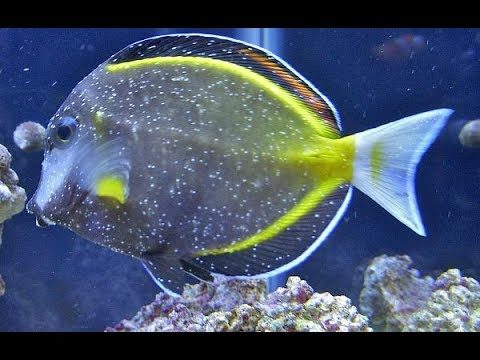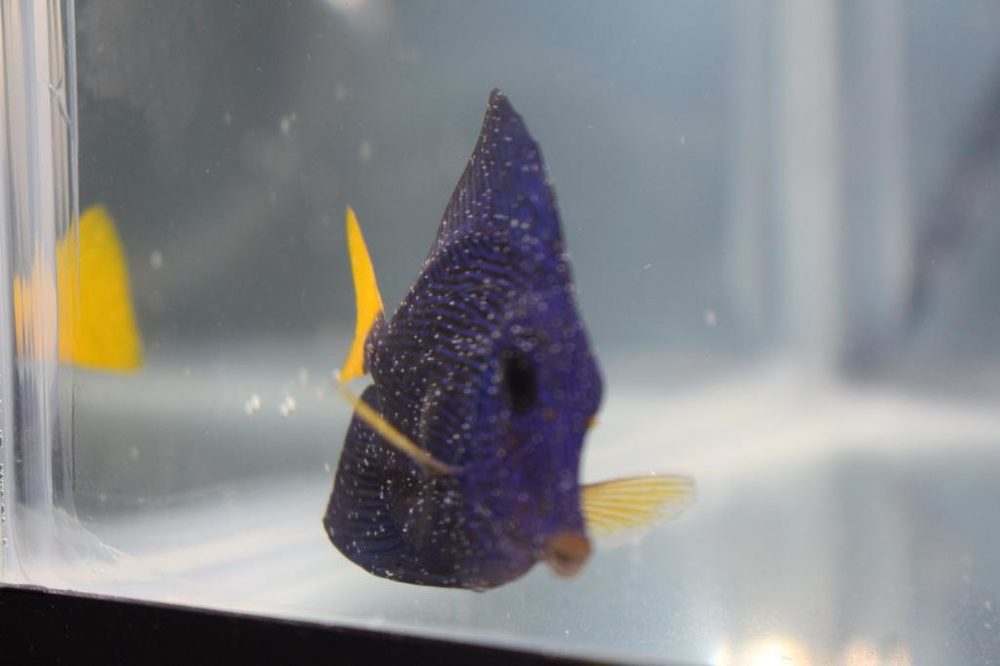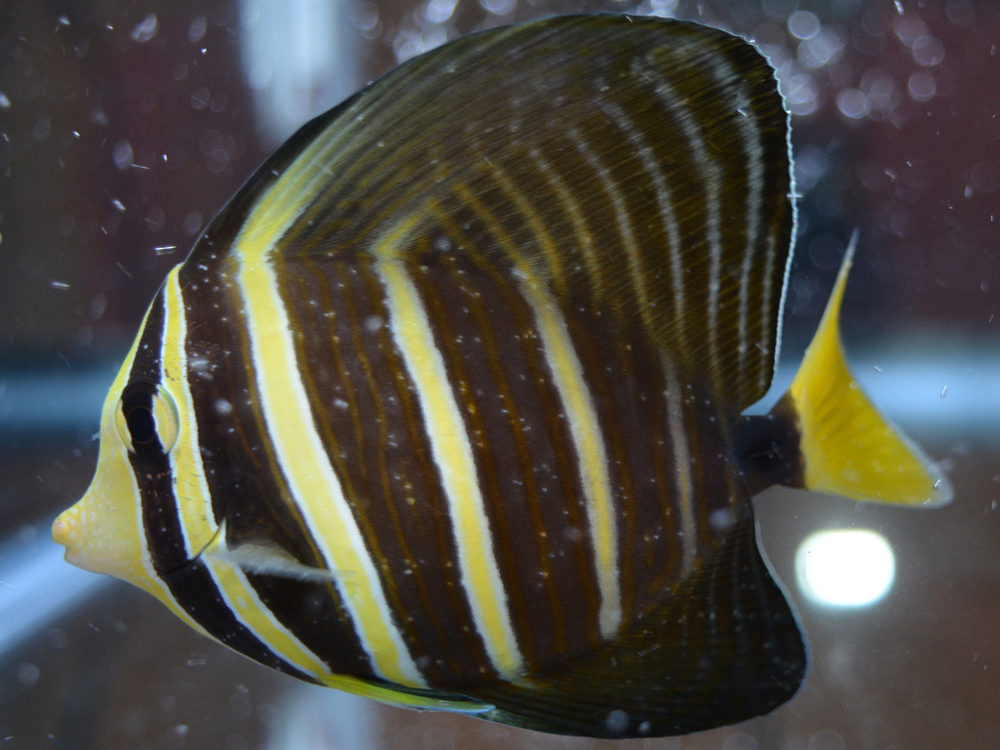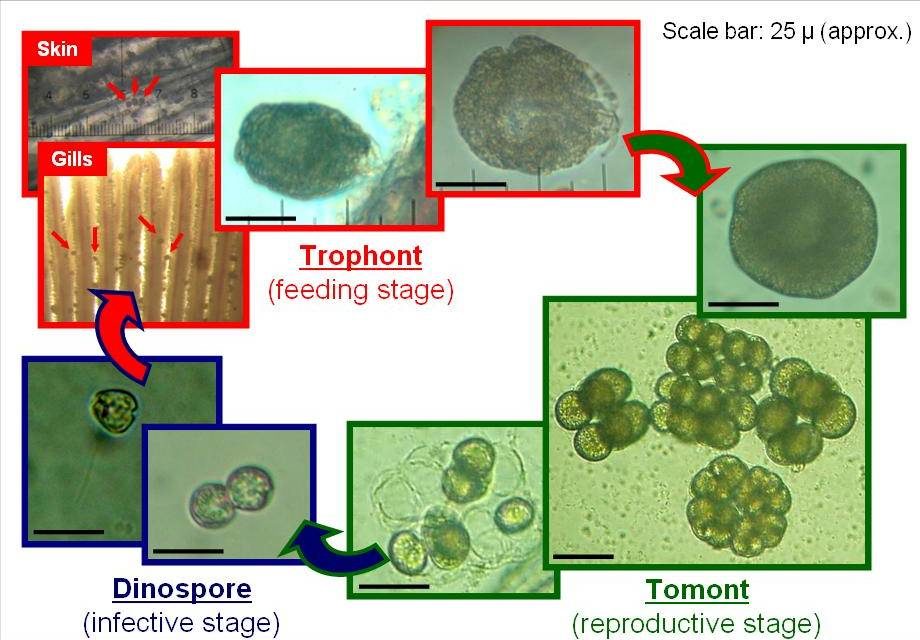- Your cart is empty
- Continue Shopping
Oodinium Parasite, Velvet

Oodinium Parasite, Velvet
This parasite is a microscopic dinoflagellate (two little “whip like organs” or flagella used to propel the parasite through the water). It attaches to the skin (then loses the flagella) of fish in order to feed. Initially it appears as small white dots (similar to ich) but is much finer giving it a “velvet” appearance. They can live without a fish host for up to 24 hours in the water. After establishing on the skin it causes the skin to break open (note the pieces of hanging skin in the picture). This allows secondary bacterial infections or fungal infection. It can cause death in a fish if left untreated.
Marine Velvet Disease (Amyloodinium ocellatum) 
What You Need To Know:
* Fast killing parasite capable of wiping out most of your fish in just a matter of days. Sometimes there are survivors, sometimes not.
* Can be treated in a quarantine tank using Chloroquine phosphate or Copper. A 5 minute freshwater dip, and 90 minute acriflavine bath (or 45 minute formalin bath) can provide temporary relief before the fish enters quarantine. Once velvet is detected, treatment should begin ASAP!
* The fallow (fishless) period for starving velvet out of a Display Tank is 6 weeks.
* Symptoms of velvet include swimming into the flow of a powerhead or wavemaker, and tiny white dots on the fins & body. The white dots can look similar to ich, but are smaller and usually far more numerous. If you can count the white dots its usually ich. However, if they are too numerous to count there’s a good chance you are dealing with velvet.
- Velvet “free swimmers” are referred to as dinospores instead of theronts.
- Velvet’s life cycle is typically faster (completed in 4 days on average), and the attacking free swimmers are more numerous than ich.
- Velvet dinospores can remain infective for up to 15 days, whereas with ich theronts it’s only 48 hours. This is because velvet tomonts and dinospores are both capable of using photosynthesis as a means of obtaining nutrients (remember it is a dinoflagellate).
Symptoms – Velvet dinospores will usually invade the gills first and sometimes kill the fish right then due to asphyxiation. If this happens, you may never see physical evidence of velvet on the skin & fins. Therefore, it is important to observe for these key behavioral symptoms of velvet:
- Reduced or complete loss of appetite.

- Heavy breathing, scratching, flashing, head twitching, erratic swimming behavior (unfortunately velvet shares all these same symptoms with ich & gill flukes.)
- Swimming into the flow of a water pump/wavemaker/powerhead (unique to velvet).
- Acting reclusive (velvet causes fish to be sensitive to light).
If visible physical symptoms do manifest:
- Velvet may initially start out looking just like ich, with salt or sugar-like “sprinkles” visible mostly on the fins.
- Within days or sometimes just hours, these tiny white dots will spread all over the fish’s body, covering it in “dust.” This dust may look grey-gold colored if viewed at the right angle and under the right spectrum of light. For this reason, it may be difficult to see velvet on a yellow or light colored fish (look from an angle, not directly from the side). However, sometimes a fish’s body will look “dirty” or show “dark areas” just before velvet appears.
There are two ways to differentiate velvet from ich:
- Velvet trophonts (and the correlating dots) are much smaller than ich. They range in size from 10-80 micrometers in diameter. They are also perfectly round. Ich trophonts are more oval shaped and range in size from 48 x 27 to 452 x 360 micrometers. Both start off small but then grow in size before dropping off. It has been said that velvet makes a fish look like it has been dusted with a fine powder, whereas ich is more like salt grains.
- If you can count the number of white dots on your fish, then you are probably dealing with ich. If they are too numerous to count, it is most likely velvet.
The importance of recognizing key behavioral symptoms of velvet and then beginning treatment immediately cannot be stressed enough. This is because once velvet has spread to the body, the fish is heavily infected and prognosis is bleak. Velvet cannot usually be managed, as ich sometimes is, due to its sheer overwhelming numbers. Sometimes it is possible in a very large aquarium (i.e. dilution of the free swimmers) if you also utilize equipment (e.g. UV sterilizer, diatom filter) capable of removing free swimmers from the water column. Survivors of velvet are usually clownfish, and other fish with a thick mucous coat like wrasses & dragonets. It is also thought a very small percentage of fish are capable of building up either natural or temporary immunity (usually 6 months max) to velvet.
Treatment Options – Chloroquine phosphate is the treatment of choice for velvet, but copper also works if symptoms are caught early on. These also work on ich, so if in doubt treating with Chloroquine or copper will have you covered both ways. A freshwater dip and/or chemical bath (discussed in more detail below) is recommended either before or during treatment, due to the severity of this disease; however these would only provide temporary relief and will not eradicate velvet.
I personally use the following treatment protocol on fish with velvet:
- 5 minute freshwater dip
- 90 minute bath using Ruby Reef Rally. Temperature control and heavily aerate the bath water.
- Treat for 30 days in a quarantine tank using either Chloroquine phosphate (60 mg/gal) or chelated copper (e.g. Copper Power – 1.75 ppm).
Final Thoughts
- You need to move with a sense of urgency when a fish has velvet. This is not the same as dealing with ich. A fish with velvet may have days or just hours to live without prompt treatment.
- A small percentage of fish are thought to be capable of building up a natural or temporary immunity to velvet (and perhaps other parasites as well). Natural immunity is less understood, but temporary immunity usually only lasts 6 months max. During that time the fish is still a carrier and capable of infecting other fish. Over the years I have noticed this trend: Clownfish, mandarins and other fish with thick slime coats are often the only fish left standing following a velvet wipeout.
- Disease masking: There is some anecdotal evidence to suggest that fish treated with a non-therapeutic level of copper will not show symptoms of ich, velvet, brook, etc. for weeks. This is why it can be dangerous to buy from LFS who treat their fish with copper but do not test daily to ensure it remains within the therapeutic range.
- The life cycle of velvet varies according to strain. The trophonts, which feed and do all the damage, can remain on a fish for as little as 12 hours or as long as 4 days. Common sense dictates you are more likely to save a fish with velvet if it’s a “12 hour variant” than one which feeds on the fish for 4 consecutive days, since the medication will not kill the trophonts still on the fish.
- Even after completing the freshwater dip and chemical bath, you will still see tiny dots all over the fish. This is because the dots you see are not the actual parasites. Velvet, like ich, is invisible to the naked eye in all forms. The dots or “dust” you are seeing is actually excess mucous buildup around where the trophonts are feeding. It will take a few days for this to diminish.
- If you can’t get acriflavine or formalin right away, daily freshwater dips may buy you more time.
- As mentioned previously, velvet dinospores (free swimmers) can remain infective for up to 15 days. By contrast, ich theronts only remain active for 48 hours, with infectivity greatly reduced just 6 – 8 hours after it leaves the cyst. What this means is that velvet has a lot more time to seek out and attach to a fish host, which partially explains why a fish with velvet is often covered in it.
- Velvet doesn’t take much of a break. Velvet tomonts release free swimmers every 4 days (on average). As mentioned above, those free swimmers can hang around for up to 15 days looking for fish to infect. Ich tomonts only release theronts (free swimmers) every 2-4 weeks (on average), with at least one strain taking up to 72 days. Since the trophont (feeding stage) remains on the fish for 3-7 days before dropping off, a fish with ich gets some relief in-between bombardments.
- Velvet likes light. As a dinoflagellate, velvet tomonts and dinospores are both capable of using photosynthesis as a means of obtaining energy. So when a dinospore ruptures from its cyst, it propels upward (towards the light) by using whip-like appendages for locomotion. Therefore, top swimming fish are probably more at risk than bottom dwellers. I highly suggest not using an aquarium light during treatment and also when running fallow for velvet (if possible in a fish only system).
- The study on aerosol transmission – which established the 10 foot rule – was done using velvet as the subject of the study. More info on that here: https://www.sciencedirect.com/science/article/abs/pii/S0044848606001785
so if you have a tank that lets say you keep a quarantine tank… and you introduce lets say a clam… which valve can take in infected water carrying disease into mouth prior to getting into your bag at the local fish store
if you plan on putting this clam one day into a display tank that has fish you should leave it in the quarantine tank for a minimum of 15 days that will take care of both ICH and VELVET that can attack fish. after 15 days you can safely put the clam in your display tank

Treatment
- Recommended treatment. High heat at 93 degrees F. for 3 days (Untergasser,1989)
- Copper sulfate based antiparasitics may be used
- Salt in the aquarium at 1 to 2 tablespoons may help prevent secondary infections (FRESH WATER ONLY)
- Clean water. Water changes increase health of discus and eliminate parasites from water.
Sources
- Handbook of Fish Diseases by Dieter Untergasser, TFH Publications, Inc 1989
- http://www.ageofaquarium.com/diseases.asp?name=Velvet
In this article symptoms include scratching, rapid breathing, and small white dots. Treatment is with a copper based antiparasitic. - http://www.aquariahobbyist.com/disease/velvet.html
In this article velvet is called a dinoflagellate (has two flagyl), and it also contains chlorophyll. The disease has a free swimming stage of the parasite. It is controlled with copper sulfate. - http://www.petswarehouse.com/Fishmed5.htm
In this article it explains the life cycle of the organism. After 3 to 7 days on the fish, they fall off and into the substrate, where they can remain without a host for up to 3 days. Here they multiply into up to 200 spores. It is untreatable on the fish, only treatable in the free-swimming stage with salt, acriflavine, or malachite/formalin. High temps also kill the parasite but this author feels it will not affect a “cure.” - http://www.noahspets.com/pdisease.html
Here treatments are acriflavine, malachite green , or copper sulfate. - http://www.aquarium.net/0597/0597_4.shtml
This article is fairly detailed including microscopic photos. Treatments include heat, quinine hydrochloride, copper sulfate, or acriflavine. - http://freshaquarium.about.com/library/weekly/aa021002a.htm
In this article symptoms include loss of appetite, scratching, clamped fins, rapid breathing and in advanced stage the skin peels off. Treatment is heat, salt or copper sulfate. - source
- source


